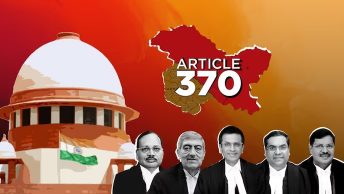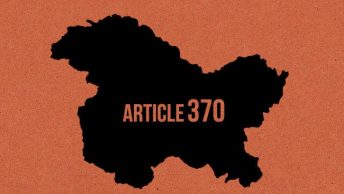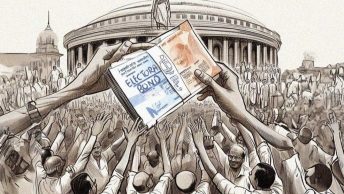Summary: In Day 7, the arguments revolved around the interpretation of Article 370, especially if after 1957, the route to amend the article through its own provisions stood closed. Senior Advocates Shekhar Naphade and Dinesh Dwivedi also presented their arguments.
The Treaty That Became Article 370 and The Berubari Case on Treaties
When the Bench was convened for Day 7, Senior Advocate Dushyant Dave took the Court through the judgment in In Re: The Berubari Union(1960), a decision passed by 8-judge-bench, touching upon the contours of the treaty-making powers and agreements. Referring to the Instrument of Accession (IoA) as a ‘treaty’ between the ruler of the erstwhile state and the Governor-General of India, Dave said that the treaty had been transposed into an extraordinarily unusual provision in the form of Article 370 of the Indian Constitution. He read the following passage from the case:
“This power, it may be added, is of course subject to the limitations which the Constitution of the state may either expressly or by necessary implication impose in that behalf; in other words, the question as to how treaties can be made by a sovereign State in regard to a cession of national territory and how treaties when made can be implemented would be governed by the provisions in the Constitution of the country. Stated broadly the treaty-making power would have to be exercised in the manner contemplated by the Constitution and subject to the limitations imposed by it. Whether the treaty made can be implemented by ordinary legislation or by constitutional amendment will naturally depend on the provisions of the Constitution itself. We must, therefore, now turn to that aspect of the problem and consider the position under our Constitution.”
Constitutional framers devised Article 370 as a form of respect, validity, and acceptability to IoA. To assure the people of J&K of its promise, the framers of the Constitution felt that Article 370 was a way to extend respect. Therefore, the treaty (IoA) has to be interpreted in light of Article 370.
He continued to read from Berubari:
Therefore our conclusion is that it would not be competent to Parliament to make a law relatable to Art. 3 of the Constitution for the purpose of implementing the Agreement. It is conceded by the learned Attorney-General that this conclusion must inevitably mean that the law necessary to implement the Agreement has to be passed under Art. 368.
Therefore, legislative power cannot be used to undo the treaty. Only the constituent power in the form of Article 368 can be exercised in respect of Article 370. He comes back to Berubari:
It is significant that Art. 3 in terms does not refer to the Union territories and so, whether or not they are included in the last clause of Art. 3(a) there is no doubt that they are outside the purview of Art. 3(b), (c), (d) and (e). In other words, if an increase or diminution in the areas of the Union territories is contemplated or the alteration of their boundaries or names is proposed, it cannot be effected by law relatable to Art. 3. This position would be of considerable assistance in interpreting Art. 3(c).
Continuing to quote from the judgement, Dave explained the contours of Article 368. Article 368 postulates that the requirements prescribed under the provision, including the ratification by both houses of the parliament by two-thirds of the house present and voting, apply to laws passed in regard to the implementation of agreements.
The language of the case speaks of the protection extended in treaty matters, and resorting to executive power authorizing him to do away with Article 3 in the garb of powers under Article 356 is a mockery of the constitutional safeguards. Dave reminded the Court of majoritarian power and how, during the emergency, this power was displayed. The Court must strike down the actions of the Executive and the Parliament if the principles of the Constitution have not been followed in letter and spirit. Therefore, a ‘treaty’ has to be interpreted in light of what the Constitution provides regarding that treaty. If the treaty has to be ‘touched,’ however, it can be done in the exercise of constituent power, not a legislative act.
Is Article 370 Temporary?
Dave then came to the question of the temporariness of the provision. Chapter XXI of the Constitution of India, containing temporary, transitional, and special provisions, does not give an accurate position of the stature of the provision on a plain reading. Article 370 is, in fact, temporary as it is titled temporary, but it is temporary from the perspective of J&K, not the Indian Republic. The choice was left to the Constituent Assembly of J&K. N. GopalaswamiAyyangar’s statement before the Constituent Assembly also testifies to this as a response to the “extraordinary situation” of J&K. The citizens of an independent country (referring to J&K), said Dave, were persuaded to cede to the Union of India by Article 370.
Dave later also submitted that the temporariness of the provision was on account of the objects achieved and actions taken. He also said that in terms of Article 370, the people of Kashmir wished to join India and have the Constitution of India apply to them. In terms of the Basic Order of 1954, he said, the President accepted the will of the people to be a part of India.
The Importance of Article 370(1)(c)
The journey of Article 370, says Dave, has to begin with Article 370(1)(c). To understand the significance of Article 370, Article 370(1)(c) becomes most important, which states that “the provisions of Article 1 and of this article [referring to Article 370] shall apply in relation to that State.” This also means that no other provision will apply. This is an emphatic statement. After Article 370(1)(c), Article 370(1)(d) becomes essential in the sense that it confirms the express application of Articles 1 and 370 alone is warranted in respect of J&K. However, other provisions of the Constitution of India may apply after “consultation” with the State if it relates to IoA and “concurrence” of the State government if outside IoA. State government must be understood in the context of democracy, not Article 356, in which the Governor exercises omnipotent powers.
Constitutional and Legislative Powers
The powers under Articles 370(1)(c) and 370(1)(d) can be identified as laying down constitutional powers. Similarly, legislative powers are added by Articles 370(1)(a) and 370(1)(b). Once 370(1)(b) “limits” powers to matters in the Union List and Concurrent List, in consultation with the State government, declared by the President to correspond with the Instrument of Accession, the decision has to be ratified by the Constituent Assembly. The entire power of approval was left to the Constituent Assembly to decide whether Article 370 was to be repealed. Also, for the President to exercise her powers, prior consent of the Constituent Assembly is necessary.
Did Article 370 Achieve its Purpose once the Constituent Assembly was Dissolved?
CJI Chandrachud queried whether it is correct to assert that Article 370 has achieved its life. He said that saying so is belied by the constitutional practice as even after 1957, orders were continuously issued modifying the constitutional relationship between the Union of India and the State of J&K. Therefore, Article 370 continued to operate even thereafter, and it would not be correct to say that the provision achieved its life as a temporary provision attained a state of permanence. Dave said that before the formation of the J&K Constitution, the approval of its Constituent Assembly was sought. CJI then said that if the Constituent Assembly took its decision in 1957, there was no power to change any provision of the Constitution about J&K. Dave says that the Assembly had to decide whether they wanted to continue the relationship. CJI then said that if Dave’s proposition was right, the power to alter the Constitution in respect of the State of J&K did not exist after 1957. Dave said that the presence of Article 370(3) is in respect of Article 370 itself, and the Constituent Assembly’s agreement is a continuance of the provision, which becomes a permanent decision.
The Decision of the Assembly – The Illegality of the Constitutional Orders for 64 Years
The CJI made an interesting observation concerning the use of the word “decision,” as used in Article 370(2), while the proviso to clause 3 uses the expression “recommendation,” both requiring some action on the part of the Constituent Assembly. If the petitioners’ argument-once the Constituent Assembly completed its task in 1957, and there was no question of invoking the proviso to clause 3, and Article 370 became permanent- were to be considered, then there could be no amendment to the Constitution at all under Article 370(2). Dave said nothing was left to be done as Article 370 was entirely in operation. If the power under the proviso to clause 3 has exhausted itself, asked the CJI, how is the exercise of the power for 64 years explained? Dave says there is nothing wrong with exercising power as it has continued as a practice, and the only question is whether it can be repealed. The CJI said that if the power under Article 370(3) has ceased, there is no power to any constitutional orders passed from 1958-2018. Dave did not talk about the illegality of such orders as he reminded the judges of his submissions regarding the power to revoke Article 370, insisting on the continued relationship between J&K and India. Dave’s arguments became rhetorical as he invoked people, saying the constitutional orders applied in that fashion as there was nothing wrong with people wanting it that way. There was no engagement with respect to the illegality of the constitutional orders passed post-1957.
Senior Advocate Shekhar Naphade commenced his arguments as Dushyant Dave completed his.
The Legislative Assembly as a Product of the Constituent Assembly
Naphade argued that the fundamental concept of constituent assembly cannot be replaced with legislative assembly, which is a product of constituent assembly. J&K Constitution was a product of the Constituent Assembly. He argued that there was no provision in the Constitution of India by which Article 370 could be abrogated. The question is whether the abrogation can be achieved through Article 370(1)(d), which recognizes the Constituent Assembly. Naphade also said that the Constitution of India recognized the existence of the J&K Constitution. In addition, if a sovereign authority convened the J&K Constituent Assembly, that sovereignty merges into the sovereignty of the Constituent Assembly, and it ultimately gets transferred to the Constitution of J&K.
There are two routes to abrogate Article 370. One is the provision itself, which was closed after 1957, and the other is Article 368. Referring to the judgment in Sampat Prakash, Naphade says that the Article 368 route of amending or revoking the provision also stands closed. It is noted by the author, that even though the Supreme Court in Sampat held that “the Constituent Assembly of the State did not desire that this Article [370] should cease to be operative and, in fact, expressed its agreement to the continued operation of this article by making a recommendation that it should be operative with this modification only,” the Centre, in this case, was given the power to redefine the relation between the two entities constantly. For a broad reading of the idea, readers are directed to Zaid Deva’s article here.
Naphade argued that since the J&K Constitution creates the executive and the legislature of J&K, these provisions cannot be done away withby taking recourse to Articles 3 and 4.The existence of the J&K constitution also limits the power of the President under Article 370(1)(d) and the power of parliament under Articles 3 and 4. Naphade also referred to Thiru K.N. Rajgopal vs Thiru M. Karunanidhi &Ors (1971), saying that the Presidential proclamation under Article 356 is clearly without jurisdiction, the reason being that the Governor had already dissolved the legislative assembly and assumed all the powers of the State.
An Excerpt from the judgment (also read this explainer in The Hindu):
“…the Governor is not elected but he is appointed by the President under Article 155 of the Constitution and Article 356 of the Constitution makes provisions in case of failure of constitutional machinery in the State. But when an assembly is dissolved there is no failure of the constitutional machinery within Article 356. Article 164(2), which provides that the Council of Ministers shall be collectively responsible to the Legislative Assembly of the State has to be read in the same manner as we have read Article 75(3).”
Senior Advocate Dinesh Dwivedi commenced his arguments after Naphade. Dwivedi said that the Instrument of Accession would only surrender sovereignty if there were a merger agreement, as in the case of other states. The other states, explained Dwivedi, not only acceded before 15th August 1947, they signed as a precondition that they’ll sign the standstill agreements that covers the matters of local concerns, after which they acceded to the Union of India.
The Bench rose for the day.
Aurif Muzafar is a doctoral fellow at NALSAR. He is also a Research Associate for the MK Nambyar SAARC Law Center, NALSAR.
[Ed note: This article has been edited by Archita Satish and posted by Harshitha Adari from our student editorial team]





